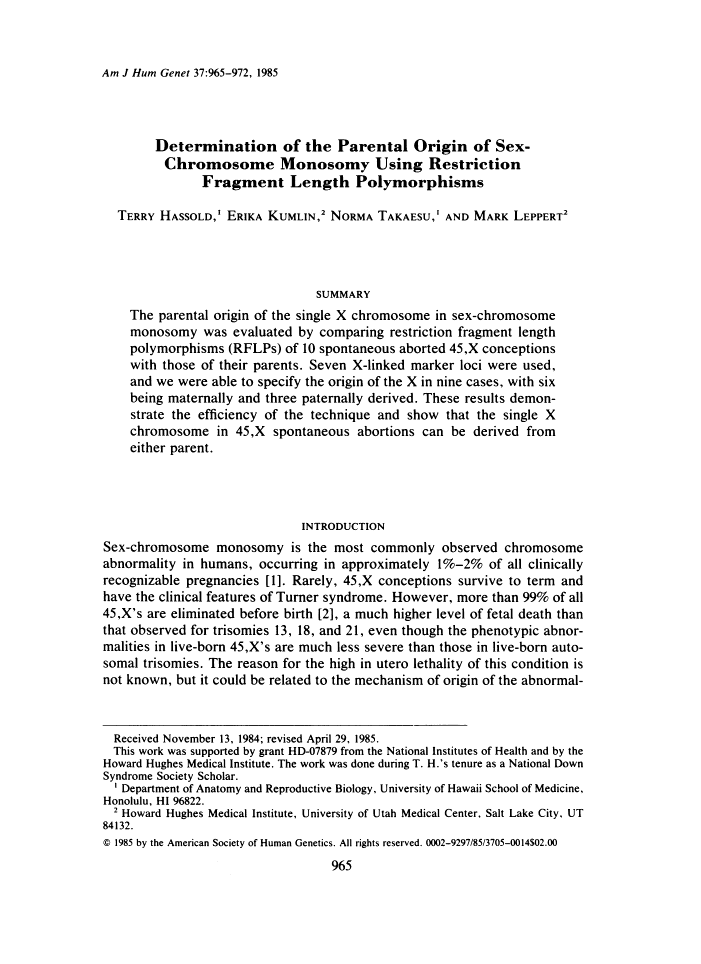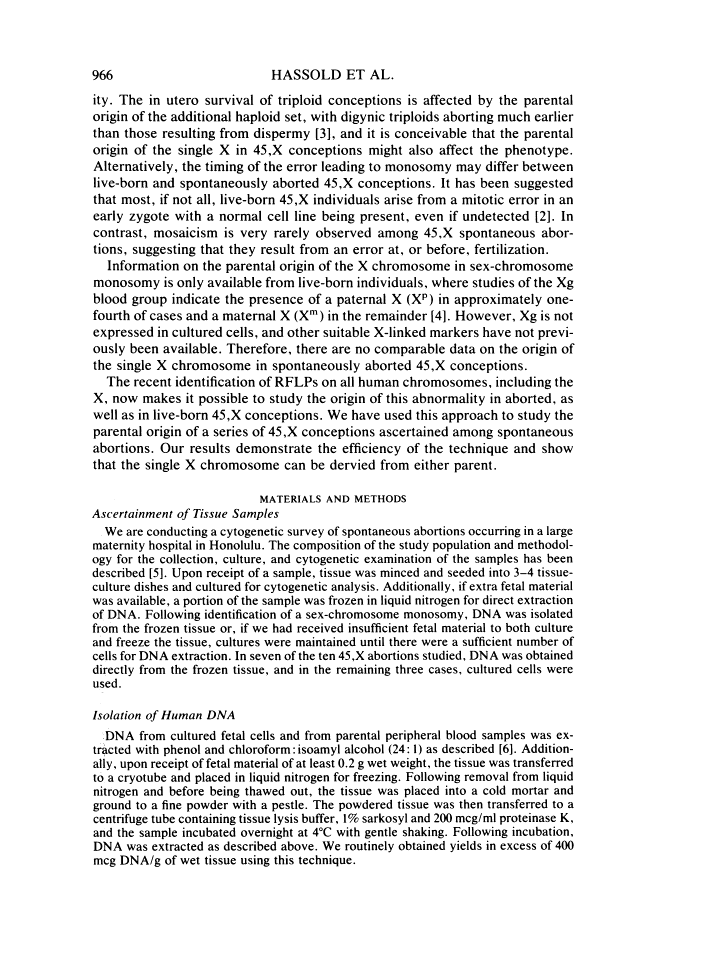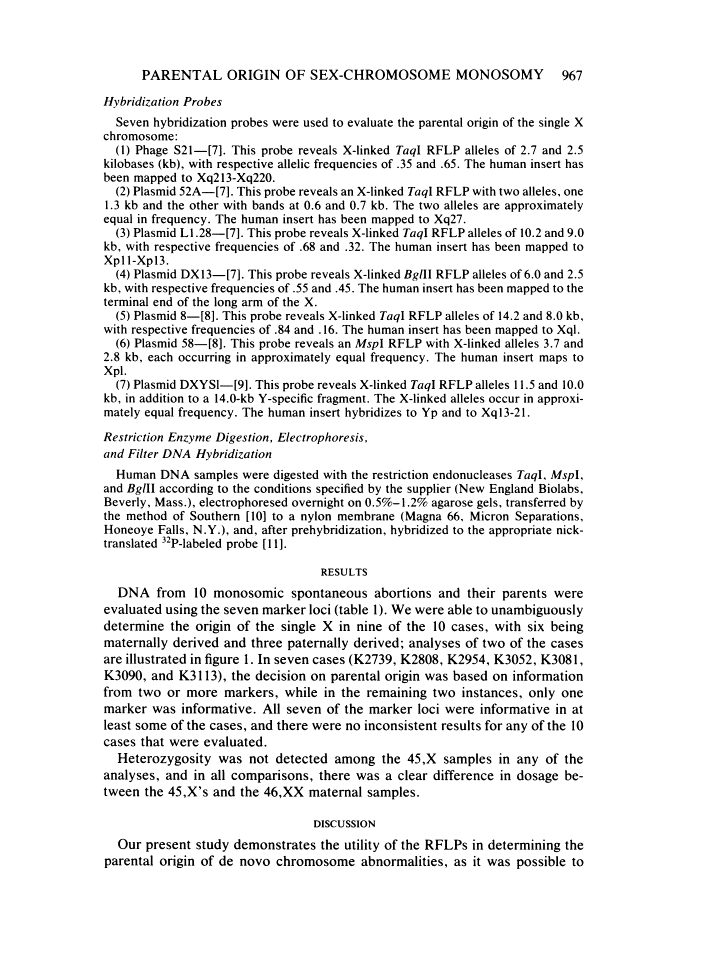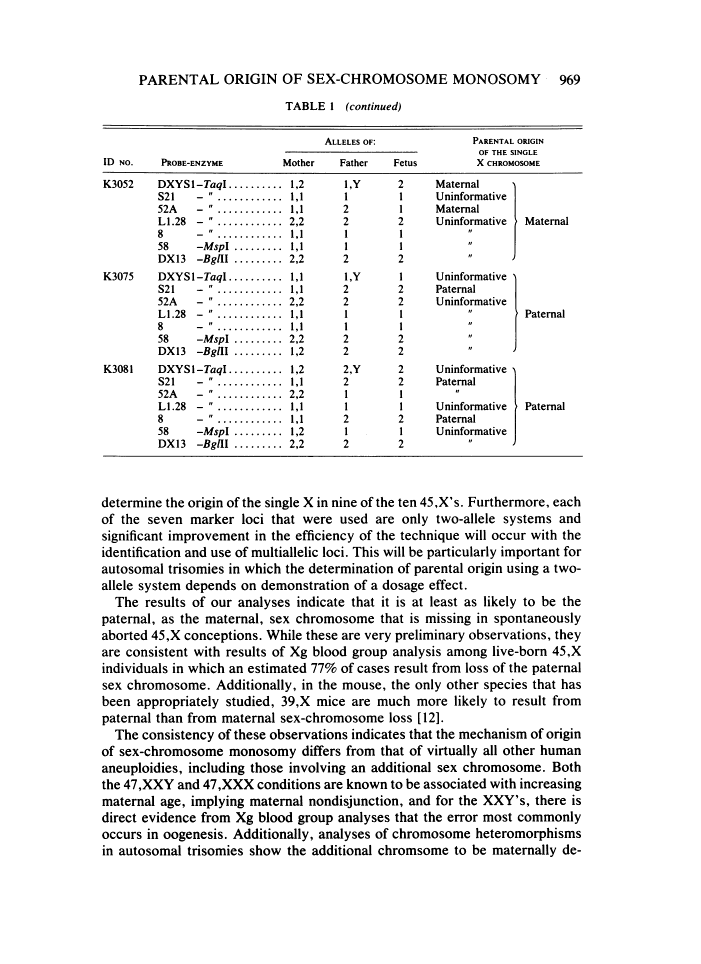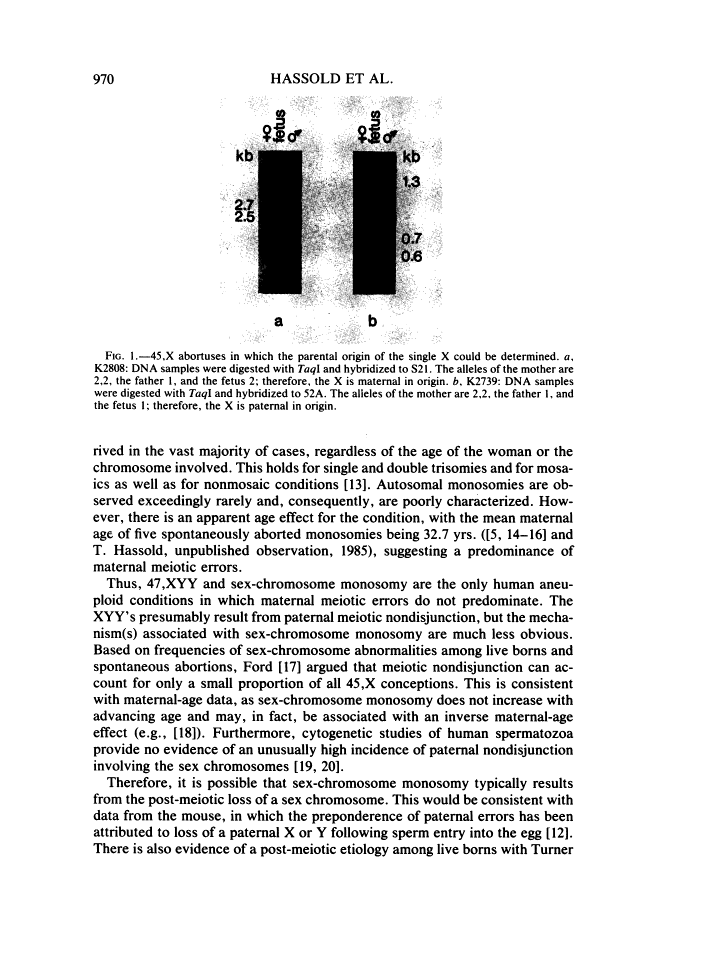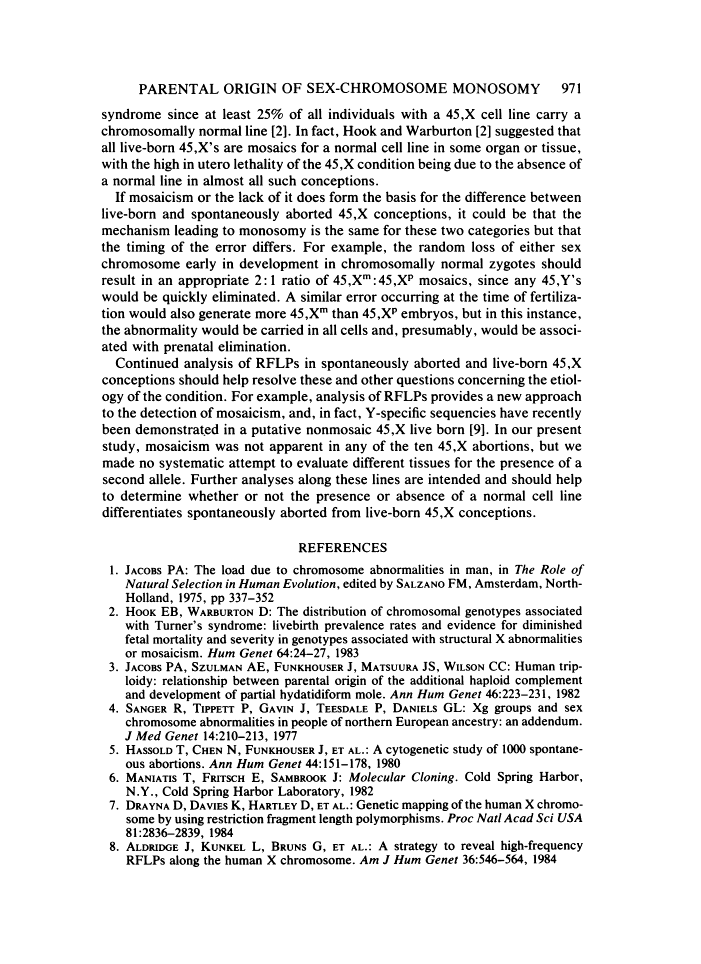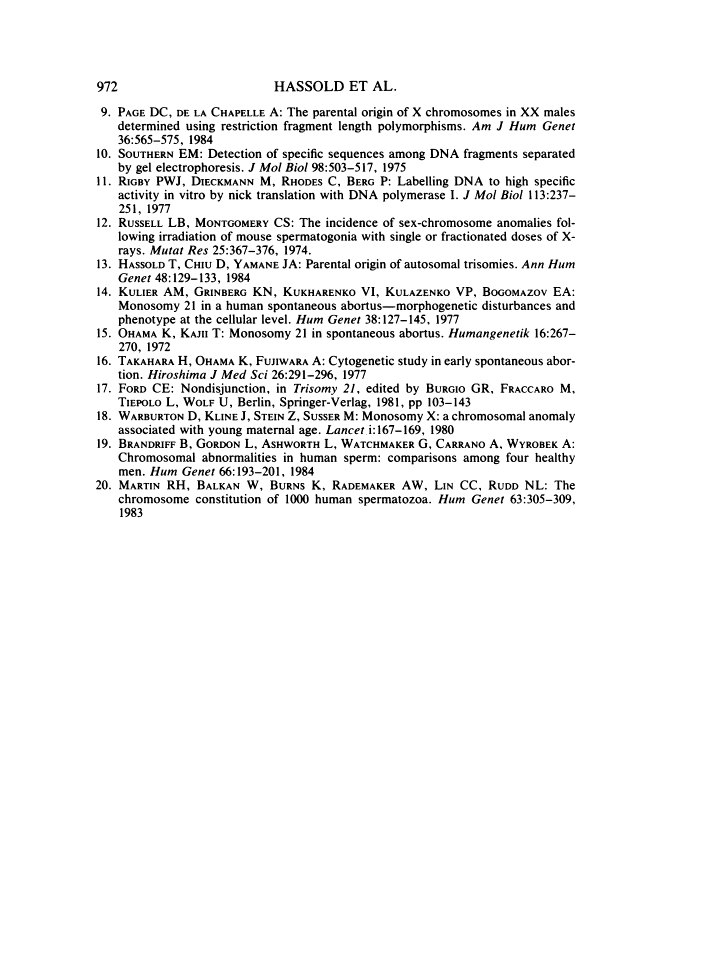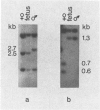Abstract
Free full text

Determination of the parental origin of sex-chromosome monosomy using restriction fragment length polymorphisms.
Abstract
The parental origin of the single X chromosome in sex-chromosome monosomy was evaluated by comparing restriction fragment length polymorphisms (RFLPs) of 10 spontaneous aborted 45,X conceptions with those of their parents. Seven X-linked marker loci were used, and we were able to specify the origin of the X in nine cases, with six being maternally and three paternally derived. These results demonstrate the efficiency of the technique and show that the single X chromosome in 45,X spontaneous abortions can be derived from either parent.
Full text
Full text is available as a scanned copy of the original print version. Get a printable copy (PDF file) of the complete article (852K), or click on a page image below to browse page by page. Links to PubMed are also available for Selected References.
Images in this article
Click on the image to see a larger version.
Selected References
These references are in PubMed. This may not be the complete list of references from this article.
- Hook EB, Warburton D. The distribution of chromosomal genotypes associated with Turner's syndrome: livebirth prevalence rates and evidence for diminished fetal mortality and severity in genotypes associated with structural X abnormalities or mosaicism. Hum Genet. 1983;64(1):24–27. [Abstract] [Google Scholar]
- Jacobs PA, Szulman AE, Funkhouser J, Matsuura JS, Wilson CC. Human triploidy: relationship between parental origin of the additional haploid complement and development of partial hydatidiform mole. Ann Hum Genet. 1982 Jul;46(Pt 3):223–231. [Abstract] [Google Scholar]
- Sanger R, Tippett P, Gavin J, Teesdale P, Daniels GL. Xg groups and sex chromosome abnormalities in people of northern European ancestry: an addendum. J Med Genet. 1977 Jun;14(3):210–211. [Europe PMC free article] [Abstract] [Google Scholar]
- Hassold T, Chen N, Funkhouser J, Jooss T, Manuel B, Matsuura J, Matsuyama A, Wilson C, Yamane JA, Jacobs PA. A cytogenetic study of 1000 spontaneous abortions. Ann Hum Genet. 1980 Oct;44(Pt 2):151–178. [Abstract] [Google Scholar]
- Drayna D, Davies K, Hartley D, Mandel JL, Camerino G, Williamson R, White R. Genetic mapping of the human X chromosome by using restriction fragment length polymorphisms. Proc Natl Acad Sci U S A. 1984 May;81(9):2836–2839. [Europe PMC free article] [Abstract] [Google Scholar]
- Aldridge J, Kunkel L, Bruns G, Tantravahi U, Lalande M, Brewster T, Moreau E, Wilson M, Bromley W, Roderick T, et al. A strategy to reveal high-frequency RFLPs along the human X chromosome. Am J Hum Genet. 1984 May;36(3):546–564. [Europe PMC free article] [Abstract] [Google Scholar]
- Page DC, de la Chapelle A. The parental origin of X chromosomes in XX males determined using restriction fragment length polymorphisms. Am J Hum Genet. 1984 May;36(3):565–575. [Europe PMC free article] [Abstract] [Google Scholar]
- Southern EM. Detection of specific sequences among DNA fragments separated by gel electrophoresis. J Mol Biol. 1975 Nov 5;98(3):503–517. [Abstract] [Google Scholar]
- Rigby PW, Dieckmann M, Rhodes C, Berg P. Labeling deoxyribonucleic acid to high specific activity in vitro by nick translation with DNA polymerase I. J Mol Biol. 1977 Jun 15;113(1):237–251. [Abstract] [Google Scholar]
- Russell LB, Montgomery CS. The incidence of sex-chromosome anomalies following irradiation of mouse spermatogonia with single or fractionated doses of x-rays. Mutat Res. 1974 Dec;25(3):367–376. [Abstract] [Google Scholar]
- Hassold T, Chiu D, Yamane JA. Parental origin of autosomal trisomies. Ann Hum Genet. 1984 May;48(Pt 2):129–144. [Abstract] [Google Scholar]
- Kuliev AM, Grinberg KN, Kukharenko VI, Kulazenko VP, Bogomazov EA. Monosomy 21 in a human spontaneous abortus. Morphogenetic disturbances and phenotype at the cellular level. Hum Genet. 1977 Sep 22;38(2):137–145. [Abstract] [Google Scholar]
- Ohama K, Kajii T. Monosomy 21 in spontaneous abortus. Humangenetik. 1972;16(3):267–270. [Abstract] [Google Scholar]
- Takahara H, Ohama K, Fujiwara A. Cytogenetic study in early spontaneous abortion. Hiroshima J Med Sci. 1977 Dec;26(4):291–296. [Abstract] [Google Scholar]
- Warburton D, Kline J, Stein Z, Susser M. Monosomy X: a chromosomal anomaly associated with young maternal age. Lancet. 1980 Jan 26;1(8161):167–169. [Abstract] [Google Scholar]
- Brandriff B, Gordon L, Ashworth L, Watchmaker G, Carrano A, Wyrobek A. Chromosomal abnormalities in human sperm: comparisons among four healthy men. Hum Genet. 1984;66(2-3):193–201. [Abstract] [Google Scholar]
- Martin RH, Balkan W, Burns K, Rademaker AW, Lin CC, Rudd NL. The chromosome constitution of 1000 human spermatozoa. Hum Genet. 1983;63(4):305–309. [Abstract] [Google Scholar]
Associated Data
Articles from American Journal of Human Genetics are provided here courtesy of American Society of Human Genetics
Citations & impact
Impact metrics
Citations of article over time
Article citations
Turner's syndrome in dermatology.
J Am Acad Dermatol, 50(5):767-776, 01 May 2004
Cited by: 31 articles | PMID: 15097963
Review
Molecular genetics of Turner syndrome: correlation with clinical phenotype and response to growth hormone therapy.
Clin Genet, 56(6):441-446, 01 Dec 1999
Cited by: 9 articles | PMID: 10665663
Susceptible chiasmate configurations of chromosome 21 predispose to non-disjunction in both maternal meiosis I and meiosis II.
Nat Genet, 14(4):400-405, 01 Dec 1996
Cited by: 200 articles | PMID: 8944019
Final height of girls with Turner's syndrome: correlation with karyotype and parental height.
Acta Paediatr, 84(5):550-554, 01 May 1995
Cited by: 8 articles | PMID: 7633152
Mosaicism in 45,X Turner syndrome: does survival in early pregnancy depend on the presence of two sex chromosomes?
Hum Genet, 88(3):288-294, 01 Jan 1992
Cited by: 89 articles | PMID: 1733830
Go to all (17) article citations
Similar Articles
To arrive at the top five similar articles we use a word-weighted algorithm to compare words from the Title and Abstract of each citation.
Cytogenetic and molecular analysis of sex-chromosome monosomy.
Am J Hum Genet, 42(4):534-541, 01 Apr 1988
Cited by: 85 articles | PMID: 2894760 | PMCID: PMC1715233
Parental Origin of the Retained X Chromosome in Monosomy X Miscarriages and Ongoing Pregnancies.
Fetal Diagn Ther, 45(2):118-124, 05 Oct 2017
Cited by: 3 articles | PMID: 28977787
Temporal changes in chromosome abnormality rate in human spontaneous abortions: evidence for an association between sex-chromosome monosomy and trisomy 16.
Cytogenet Cell Genet, 38(3):200-205, 01 Jan 1984
Cited by: 4 articles | PMID: 6541559
Morphological characteristics of monosomy X in spontaneous abortions.
Ann Genet, 31(1):4-13, 01 Jan 1988
Cited by: 25 articles | PMID: 3281569
Review
